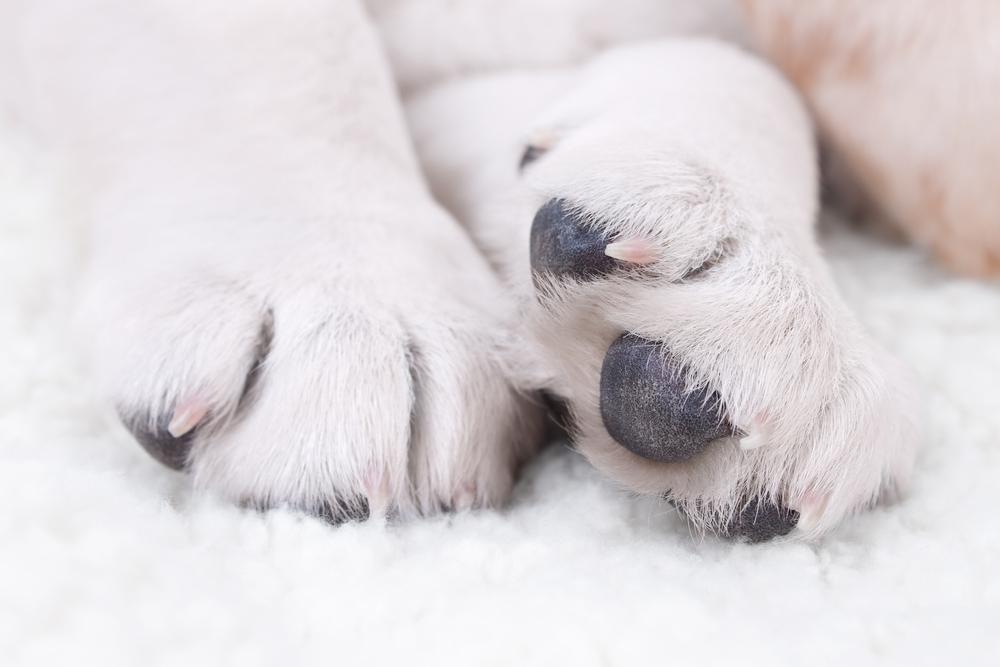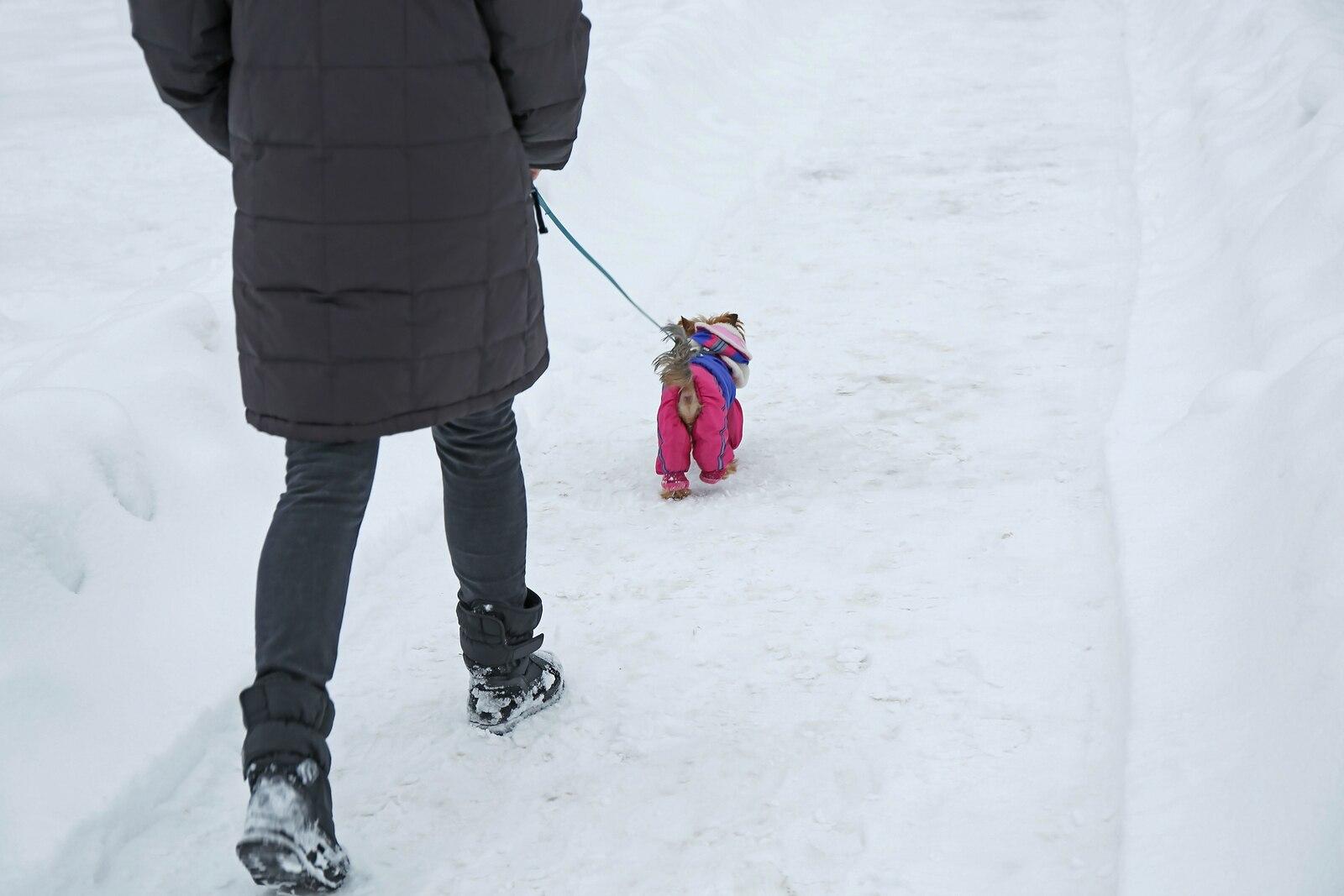

It can be hard to keep up an exercise routine in the winter. This is as true for dogs as it is for humans. Snow, cold temperatures and shorter, darker days can make walking your dog in winter unpleasant — and potentially dangerous. So, how can dogs walk in snow and stay safe? And how long can a dog walk in snow without getting too cold? Read on for some winter pet safety tips to help keep your pup safe and help you both stay active during the colder months.
Can Dogs Walk in Snow?
Walking through a winter wonderland with your pup can be a memorable experience, and it's a great way to get fresh air and exercise. However, where there's snow, there may be hazards, so stay vigilant. For example, antifreeze has a sweet taste that may appeal to dogs but can be fatal if ingested. While keeping your dog from lapping up this toxic chemical may seem easy enough, look out for spills.

Since dogs often lick their paws after a walk (and some dogs love to eat snow), keep an eye out for any harmful substances in your path. Salt and other chemicals used to melt ice after a snow can also irritate your dog's skin.
What Temperature Is Too Cold to Walk a Dog?
So, how cold is too cold to walk a dog? When it comes to what temp is too cold to walk dogs, the answer isn't cut and dried. How long your dog can be outside in cold weather and at what temperature depends on their age, health, coat and breed. Generally speaking, certain breeds can tolerate cold temperatures. But while a healthy adult Siberian husky may be perfectly comfortable taking a 20-minute walk at 20 degrees Fahrenheit, this could pose serious health risks to another dog.
Puppies, seniors, toy breeds and dogs with short (or no) fur are all susceptible to extreme temperatures. According to the American Veterinary Medical Association (AVMA), cold weather complications include frostbite and hypothermia. Dogs with certain medical conditions, such as thyroid disease or chronic lung problems, should also have limited exposure to cold air.
Know Your Pup's Limits
Your veterinarian can help you determine how long is too long depending on your dog's individual needs. In general, limit the amount of time your dog spends outdoors to help prevent hypothermia and frostbite.
Keep an eye on your pet for signs of exposure during walks, including:
Whining
Shivering
Anxious behaviors
Burrowing
Slowing down or stopping
Lifting one foot
Limping
These are all signs your dog is cold and wants to go inside. If you notice any of these behaviors while outdoors with your dog in cold weather, head indoors right away. If signs don't resolve after moving inside to a warm environment, contact your veterinarian.
Winter Pet Safety Tips
Despite these dangers, walking is still a great form of exercise for most dogs. Many dogs love playing in the snow and have no problem with the colder temperatures. With the right precautions, winter walks can be safe and enjoyable for you and your pup. Here are some winter pet safety tips to pave the way.

Bundle Them Up
Protect dogs who are susceptible to cold temperatures — including senior pups, puppies, small breeds, and dogs with short coats and low body fat — with a water-resistant coat or sweater.
Protect Their Paws
Salt and other chemicals can be irritating or downright toxic, but booties or rubber boots made for dogs offer protection from these common winter paw hazards. If your dog doesn't tolerate wearing something on their feet, you can try training tips to help them get more comfortable. Alternatively, you can coat their paws with a protective wax-based cream such as the kind used with sled dogs. Just be sure to thoroughly wipe your pup's paws before bringing them inside to remove the cream and anything else they might track in.
Avoid Ice
Be on the lookout for patches of ice on streets and sidewalks, which can pose fall risk to you and your pup. The AVMA recommends staying away from frozen ponds, lakes or other bodies of water, too. You can't be sure whether these areas will support your and your dog's weight, and it's not worth the risk.
Look Out for Dirty Snow
If your pup enjoys eating snow, avoid walking near snow that's visibly dirty or cleared by snow plows. Dangerous chemicals and hidden objects beneath the surface can pose health risks.
Bring a Flashlight
Carry a flashlight with you during walks, and consider using a reflective leash. These tools can also be helpful during the day in times of low visibility due to winter weather conditions. They'll help you see your surroundings and help others see you, too.
Indoor Exercise Alternatives
Some days may be too cold, wet or icy to walk your dog outdoors. Here are some ideas for getting them the physical activity and stimulation they need while staying warm and toasty indoors.
Play Fetch
A long hallway or a large room with an obstacle-free stretch of space is enough for your pup to chase after their favorite toy. You can also turn it into a game of soccer if your dog hasn't quite mastered returning their toys yet.
Run Up and Down the Stairs
As long as your pooch is healthy, doesn't have any joint or hip problems and can navigate stairs with no issues, a few laps up and down a carpeted staircase can be great exercise. Added bonus: You'll get your own heart rate up, too!
Play Hide-and-Seek
Hide treats or toys around the house and encourage your pup to seek them out.

Sign Up for a Class
Winter might be a good time to brush up on good manners and obedience training. A class provides an opportunity for indoor activity and a chance for you both to socialize, which can help combat cabin fever. Your pup might also enjoy agility training on an indoor course, or you might check with your gym to see if they offer "doga" — yoga classes you can do with your dog.
Brush Up on Training at Home
If taking a class isn't an option, you can still combine exercise and mental stimulation by reinforcing your canine companion's obedience skills using books, DVDs, websites or online tutorials as a guide.
While certain challenges come with walking your dog in winter, you can help make it fun for everyone, even if your pup isn't a sled dog. Paying attention to their needs and comfort, as well as keeping a close eye on your surroundings and exercising common sense, can go a long way toward ensuring a safe, active winter. Also, remember to take your own precautions when going out. Bundle up and watch your step when it's icy out. You and your dog are a team, and your dog's well-being depends on yours!






















